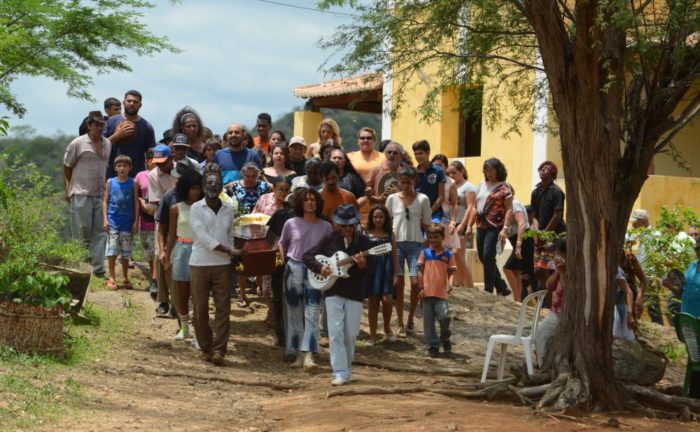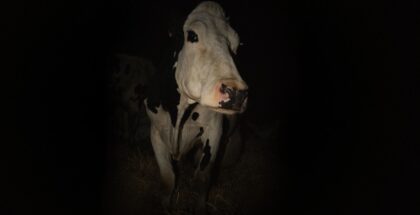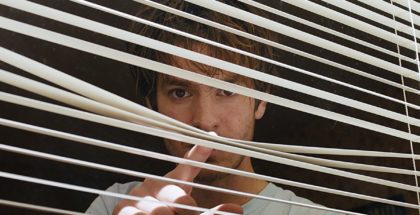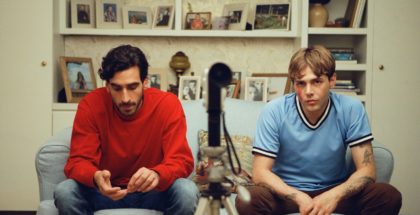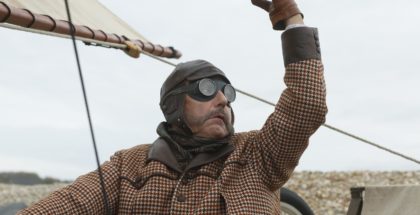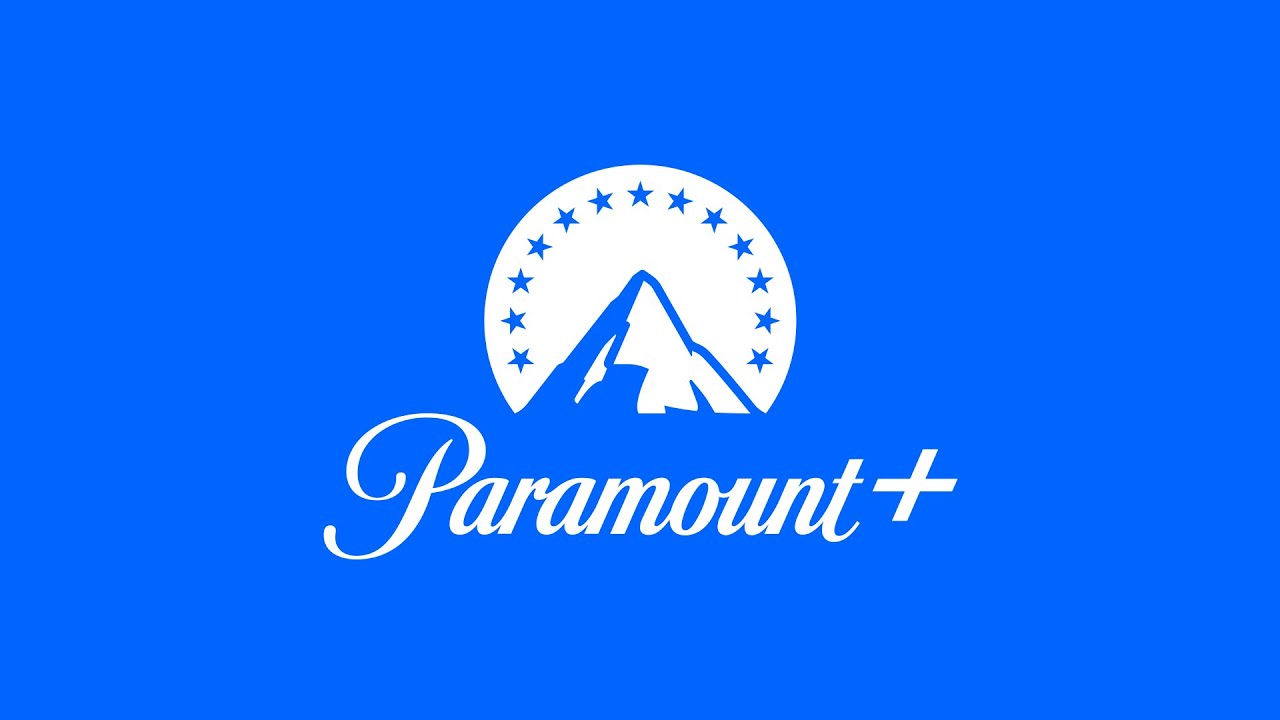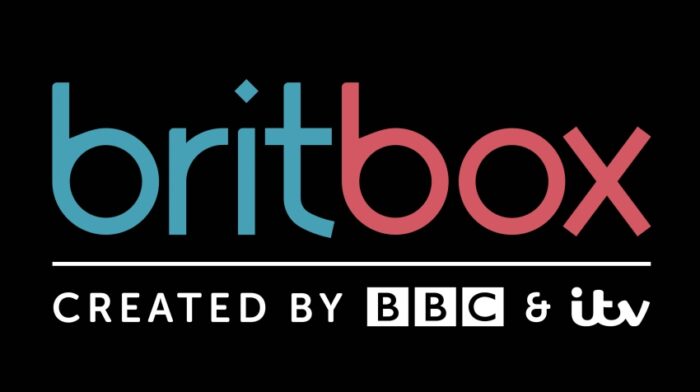Interview: Kleber Mendonça Filho talks Bacurau, genre cinema and streaming
Matthew Turner | On 14, Mar 2020
This weekend sees Bacurau released in UK cinemas and online by MUBI. The neo-Western thriller takes us to the titular settlement in Brazil’s remote backcountry, which is shaken by the death of its elderly matriarch. But something strange is happening in the village, and there’s little time for mourning. The water supply has been cut off, animals are stampeding through the streets, and empty coffins are turning up on the roadside. One morning, the villagers wake up to find their home has disappeared from satellite maps completely. Under threat from an unknown enemy, Bacurau braces itself for a bloody, brutal fight for survival.
Starring Bárbara Colen, Udo Kier and Sonia Braga, the film is directed by Kleber Mendonça Filho and Juliano Dornelles. At the London Film Festival in 20198, we sat down with Kleber to talk his inspirations, political allegory and the role streaming platforms play in modern culture.
Where did the idea for Bacurau come from?
First of all, the desire to make a genre exercise. Brazilian cinema is very attached to social realism or comedies, but it doesn’t really go into genre very much – you know, action, horror, suspense, Westerns. That was one thing, and also me and [co-director] Juliano Dornelles were very good friends, we love film and in cinema, we really share a lot of love for genre films. The other thing is that, in 2009, we were at the Brazilian Film Festival with a short film, which happened to be – this is not a coincidence – a sci-fi short film which takes place a few years from now. It’s about a strange climate change that turns a tropical city like where we come from into something like Manchester, cold and drizzly, and it changes the behaviour of the whole region, which is a tropical region. So it became a big success at this festival and it went on to be one of the most successful short films in Brazilian film history. And we were on a high because of that film and our desire to make a genre film. And then the third thing was that at the same festival we saw some documentaries which were about small communities, they were about simple people living in small communities and you know when you’re watching a film with a friend and you go [makes a face] this is not good, I don’t like this. And that’s how the idea for Bacurau began, to make a genre film in a small community. And they are great people, they’re amazing people. And they are our heroes, they are the point of view of the film, they are not the Other. In fact, the Other would be what the Other would be in some other film, that was the main idea behind Bacurau.
You mentioned social realism. Is there a real life situation that gives this film an allegorical element?
The starting point, really, is how you portray a certain part of society. This is not a Brazilian thing, this is universal. In the United States, for example, New Yorkers, people from New York and California, they look down on people from Alabama and Mississippi and Montana. The same thing happens in France, the north of Italy looks down on the south of Italy. In Brazil, the south-east is where all the money was unevenly shared, which means that the north-east was left in an economically disadvantaged situation. Which of course has many implications in the development of society and the way that the region is seen by the rest of Brazil and in the way that the north-east is portrayed in Brazilian television and Brazilian cinema. Even if the north-east is a bedrock of political resistance because of all of that – culture, art, literature, cinema, music. So I think that’s what might get lost for a foreign audience, but I think the general idea is very clear. But yes, there are specific aspects to that, which is basically this invisible force field that seems to separate us in the north-east – me and Juliano and the whole crew, we come from the north-east – from the south-east and the south. And that’s where the tensions happen, much discussed in Brazil, including the controversial scene with the meeting, where some very unpleasant aspects about race in Brazil are discussed. So that’s part of a number of things that we wanted to address and wanted to write about.
Are there also elements of gentrification, in driving out the local population to make way for building projects like hotels?
I think that’s more Aquarius. If you get down to what the film is about, I really think it’s about history, the history of conflict and invasion, wars and so on. I think history informs us – you and myself – of what can happen in society and then when you’re writing a script and you know your history, you know how far you can go in terms of addressing an issue. I mean, it is a Western, it has all the makings of a Western, but we did feel, once the script reached its final 20 minutes, it really feels like a war film. In some ways, I think it has the same structure as The Wicker Man.
I’m glad you brought up The Wicker Man. Were there any films in particular that inspired Bacurau?
There are many levels of references in a film like this. When we were writing the script, we would get stuck and we’d go downstairs and we’d pick a film from the collection and watch it. And hopefully that film would get us back to writing, with one idea, with one scene, with one image, with one word – that happened a few times.
Can you think of any specific examples?
One of the best examples was a film by Sergio Corbucci from 1970, called Compañeros. That film gave us a certain roughness that I think Bacurau has. It’s an Italian spaghetti Western, which means that they are rougher than the American Westerns. They are glossier, the American Westerns, from the image to the clothing to the scenery. With the Italians it’s like you’re unsafe, watching them. They are more irresponsible and this is something we loved in Compañeros. But we saw Rio Bravo and The Searchers. The Searchers has the scene where the little girl is approached in the middle of the night by an Indian and they cut to a medium shot of him, it’s quite startling. That’s also in Bacurau. And then other things happened. We were editing the film and in the scene where Pacote is taking his dead friends in the Jeep, he’s driving and screaming at them and talking to them, Juliano pointed out that it was Bring Me The Head of Alfredo Garcia. It is, but we never really discussed it. It’s a film we like very much. So it works in many strange ways and to this day, people come and say, oh, I saw the reference for such-and-such a film.
It reminded me of Bone Tomahawk, just in the slow build…
I like that. I also like the fact that the first half hour of Bacurau is like a slice of rural Brazilian life. And I really like that people are watching this and then the film slowly morphs into something completely different. And some people have strong reactions, it’s like their jaw drops.
Was there a model for the slow build? How did you work on that?
Well, it comes from our love for, particularly, American films from the 1970s. You actually tell the story. Halloween, for example – the first half hour is actually, so this is the neighbourhood, these are the people, these are the girls, they are friends and then they have boyfriends, this is the house, this is the other house, this is the doctor. And then when they begin to die, you know who’s dying and you’re invested in them. It’s so basic, but it’s not really done these days. So in Bacurau, we take a lot of time to introduce the community, this is where the museum is and these people, the doctor, blah blah blah. I think we saw Die Hard – which I think is a very good Hollywood action film – and that takes 18 minutes to establish. Nothing happens and then something happens.
Typically, there’s supposed to be a 20-minute rule, isn’t there? When you’re reading the script, you’re supposed to know by page 20 who your main character is…
I don’t care about that rule – I care that the early readers of the script (and they’re very important for me), I care that they are compulsively reading, even if they might be saying where is this going? It has to be a page-turner, even if you might be bothered by the fact that it hasn’t begun yet, but this is interesting, this is interesting. And then if it works, you’re like, oh, wow, 34 pages. The first 34 pages were a beautiful read, because you’re always interested.
Udo Kier is almost a totemic actor for this kind of picture. How did you get him involved?
I met him at a film festival in Palm Springs. That’s where he lives, in fact. I was there for the Variety Ten Names To Watch awards, and then Dorota Lech, she’s a programmer, she introduced me to Udo and we had a great conversation, while drinking. And I felt so lucky that I got to meet him and now I was beginning to play with the idea of having him in the film. Juliano, of course, was incredibly enthusiastic. When I sent him a message – “I just met Udo Kier, he’s amazing, he’s funny” – and then Udo loved the script, he loved [the part of] Michael, he had a few ideas, which we loved. Sometimes it’s awkward, the actor or actress has a few ideas and you don’t care for the ideas, but he had great ideas. And then he came to Brazil to shoot the film and we spent 18 days together. It was an amazing experience.
What sort of ideas did he bring?
When he screams “this is only the beginning and the end”. I thought this was crazy, insane, kitschy and scary. Let’s do it. Also the line “there are so many things you can do with a knife”. What? Yeah! That’s crazy. And it’s in the film.
Do you have a favourite sequence in the film?
Luckily I’m very happy with the film, and with many of the scenes. But one that I still think is quite a standout for me is when Jake and Julia kill some people and then they go on to have sex. I think that’s a very strange scene, it still takes me back a little, it’s so violent and so demented. And then the drone and the music, UFO-like and it’s at night. It’s a scene that is quite strong, I think.
How did you work on getting the tone right?
I don’t think it’s possible to answer the question, because it has to do with whatever it is that we could do with the film. It has to do with the different elements, with whatever talent it is that we have and… I don’t know. But it seems to work in a strange way. We liked the ideas and we made them work together. But sometimes you have a good idea and then you have another good idea, but to make this idea work you have to come up with two other ideas, because otherwise it’s going to be a challenge and impossible to accept. So this idea only works with this idea because there are two other ideas that have to be built from scratch.
How hard was it to get the gore effects right? I’m thinking of the head sequence in particular.
It was many months work. A lot of Skyping with this wonderful guy in Los Angeles. We had to draw the sequence to make sure that it made sense and I’m very happy with it, because it was always about not many shots. The set-up is very concise, it’s almost one shot. And we had that fantastic head. The head was divided into five or six parts, which had magnets, so re-setting was very easy. I think we got it in one take. And then we had to just throw a dead body on the ground. And that is the Verhoeven moment, as it were, the Cronenberg moment, because it goes one step further than probably most people would do. That was the one very strong, graphic moment and I thought if we had that in – I mean, the other scenes are also violent but that one is the piece de resistance – it’s a moment that audiences react to with catharsis.
Did you use any non-professional actors?
We have all kinds of actors in the film. We have Udo [Kier] and Sonia [Braga], who are stars, we have very good professional actors of all ages, and then we have actors who are not professional and then we have amazing extras. And I think this is one of the rare films where the extras were actually prepared to work on the film. They were given almost like dramatic preparation. Because the problem with extras, in most films they are treated like objects, the stool over there could be an extra. But in this film they had to look right and of course they look right and they act right and above all, they understood the situation. It’s widescreen and you have 18 people, they’re all extras – or maybe a couple are professional actors, but if you look at them they’re all perfect, they all have this tension in their faces. You could have 18 people and then that guy will be thinking about his laundry and he would ruin the shot, like in Bruno, the Sacha Baron Cohen extra who ruins the shoot. So we’re very happy with the human landscape in the film.
So you’re not using real villagers then? They’re all professional extras?
No, no, no, no. I forgot to point that out. They are from the village and they are from other villages in the region. They’re amazing. All the extras are from the village where we shot Bacurau and from neighbouring villages.
And they hadn’t acted before?
Never. For instance, the wonderful old lady who says “some outfit kid”, when Lunga comes into town, she’s amazing and she’s never acted before. And she’s become a meme in Brazil and a star, because her line is so memorable.
The film is on MUBI in the UK…
Yes. MUBI are going to release it in cinemas, theatrical, and then streaming. And I’m very happy that it’s MUBI’s release.
What are your feelings towards streaming in general?
I think it’s an amazing tool, I use it all the time. The only problem I see is that it has replaced the idea of buying the film, physically, in the culture. I’m still one of the few people who buy physical media, Blu-rays and so on. There is nothing wrong with streaming, it’s a by-product of streaming, in that it has given people the wrong notion that everything is available, and it isn’t. People say I won’t buy it because it’s on Netflix and it’s not anymore, because the contract expired last week. Or maybe it never was on Netflix in the first place. But it’s beautiful when you look at MUBI and see a wonderful selection of films and you feel like somebody did that.
Yes, MUBI is curated…
Yes, and Netflix doesn’t feel curated in any way. You find what you never never thought you would find and you don’t find what you expected to find. It’s like… what? But Netflix has become part of many people’s lives, streaming has become part of many people’s lives.
What sort of things have you watched and enjoyed recently?
I usually keep watching the same classic films, or the classic films that I love. But sometimes I watch new films, for instance, last year, in December, on the day of its worldwide release, I actually sat down with Emily, my partner, and we saw Roma, big screen, 4K. And I felt it was really modern, in a way, to watch a film that was being released worldwide in amazing quality at home, with amazing sound. But I don’t know, it’s still very strange. I saw an interesting article on Variety last week about The Irishman maybe being too good for what Netflix wants to do with The Irishman. I thought it was an interesting think-piece. Because a film is not only the film – the film is what it can do to culture. And luckily, I have experienced this with my three films. In different scales, but it has happened, and it’s happening right now with Bacurau. The theatrical release of Bacurau in Brazil has become a cultural event. It has become part of the conversation. So when it’s finally shown on MUBI, I think it will be a bigger film than if it had never been shown in cinemas. So The Irishman has all the makings of a film that could be part of culture through cinema, through the movie theatre experience, but no. Well, in America they’re going to give it three weeks, but it’s not going to happen in Brazil.
It’s getting some simultaneous screenings round the country with its LFF screening and it will have some limited theatrical screenings when released
Yeah, but that’s nothing for a Scorsese film with Pacino and De Niro and Pesce. So, it’s crazy. It’s a crazy moment. I’m old-fashioned. I think a film should have many lives. And they should be on Netflix. But it’s crazy to file the film away on Netflix. Maybe that’s how they work. I don’t know if it can become part of culture alone, just because it came on Netflix. There are many films that are added to the catalogue and you go, huh, really, it was released? And then it creates a paradox – Scorsese himself is addressing this. Without Netflix, The Irishman would never exist, because Paramount or any other studio would never invest so much money in a film like that. But because of Netflix, it doesn’t become part of culture in the same way. Or maybe it will? I don’t know.
I guess it has to? I mean, everyone will still watch it, but they won’t have the experience of watching it together, with a cinema audience
I can’t deny that. The Brazilian documentary, The Edge of Democracy, that went straight to Netflix and at some point, everybody was talking about the film for two or three weeks, which is probably more than it would have done if it had gone to cinemas, but I don’t know, because it didn’t go to cinemas. I don’t know how to address this, but I much prefer, as a film=maker, to have the film having its life in cinemas, whatever life it is, a huge success or a failure, but it’s gone to cinemas, then digital platforms, Blu-ray, TV, that’s what I like.


